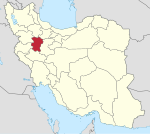|
Qohurd-e Olya
Qohurd-e Olya (Persian: قهوردعليا)[a] is a village in Mehraban-e Sofla Rural District of Gol Tappeh District, Kabudarahang County, Hamadan province, Iran. DemographicsPopulationAt the time of the 2006 National Census, the village's population was 944 in 237 households.[4] The following census in 2011 counted 1,008 people in 263 households.[5] The 2016 census measured the population of the village as 934 people in 293 households. It was the most populous village in its rural district.[2] See alsoNotesReferences
|
||||||||||||||||||||||||

